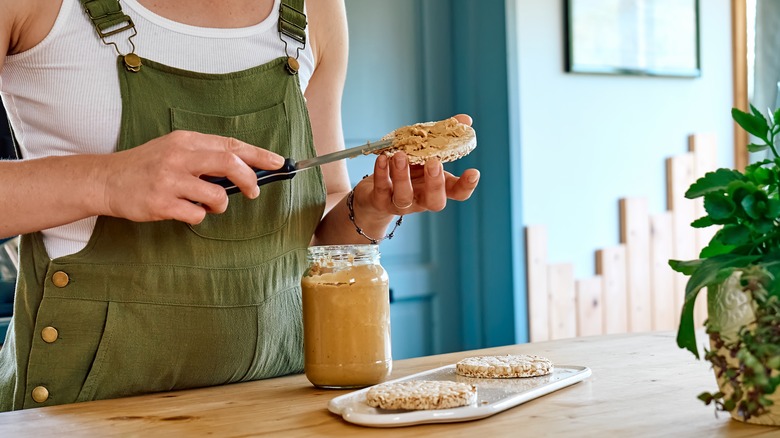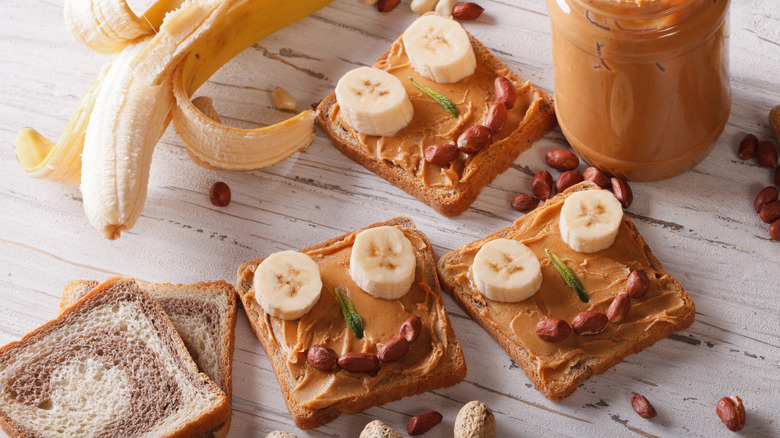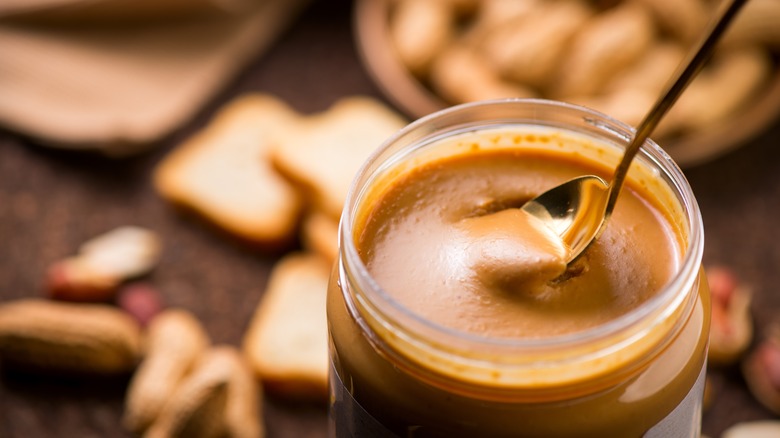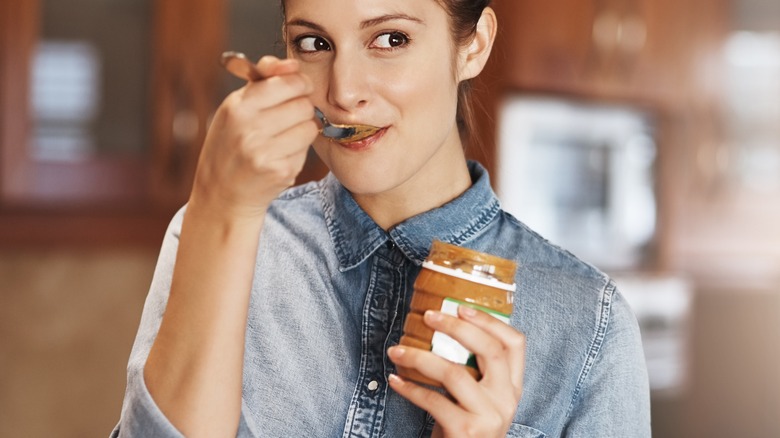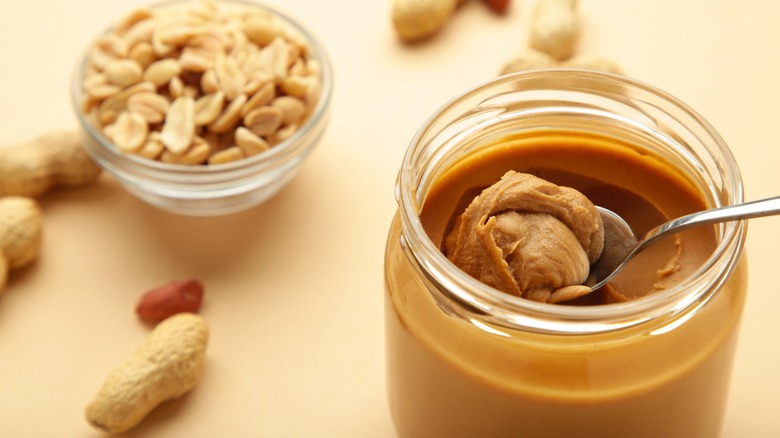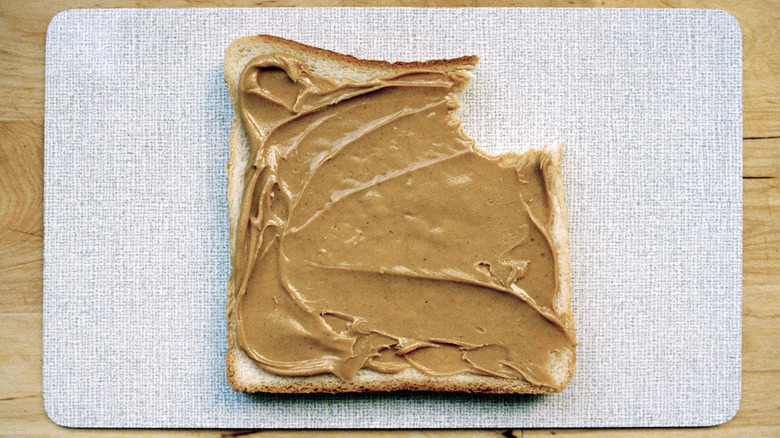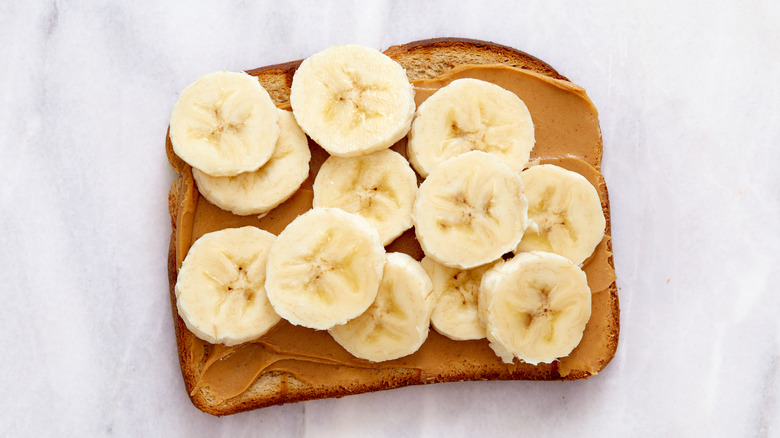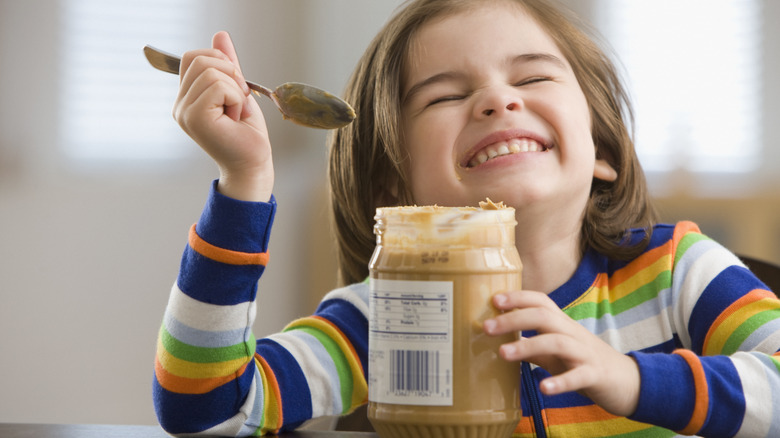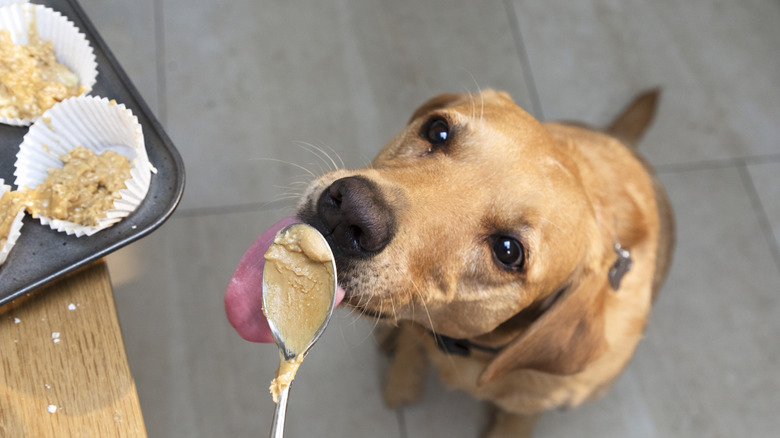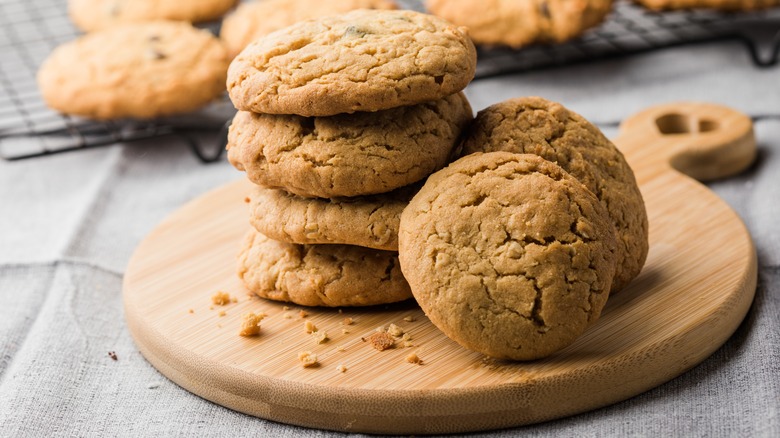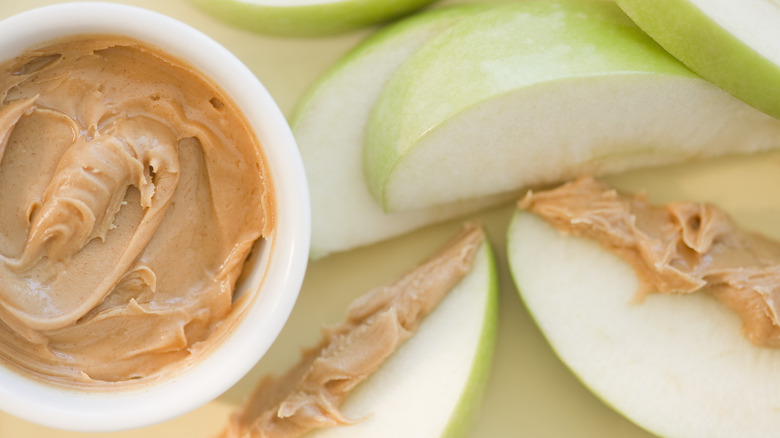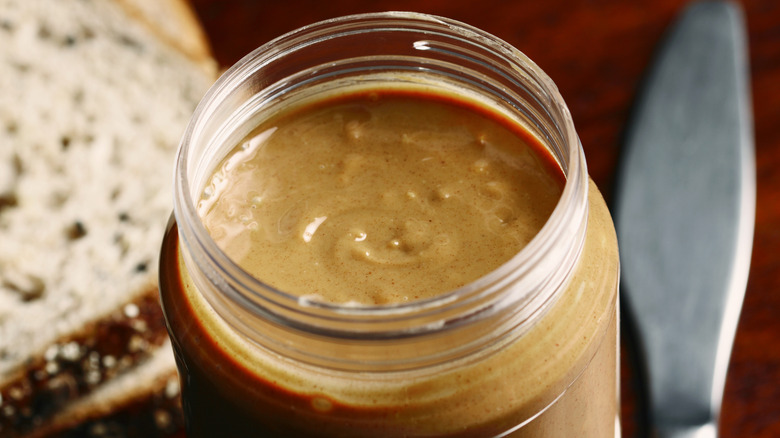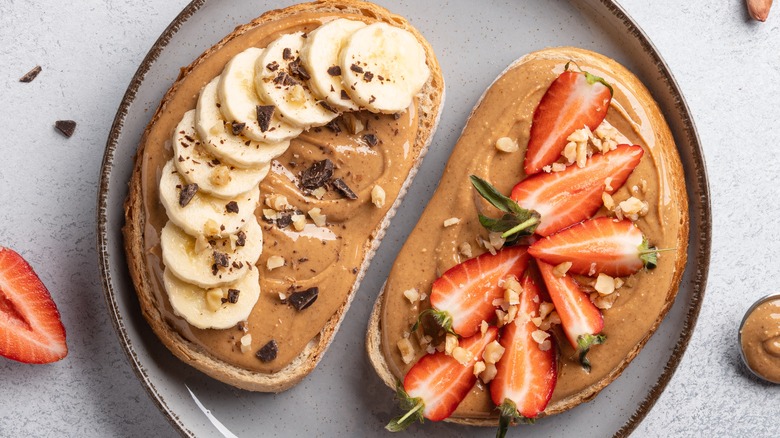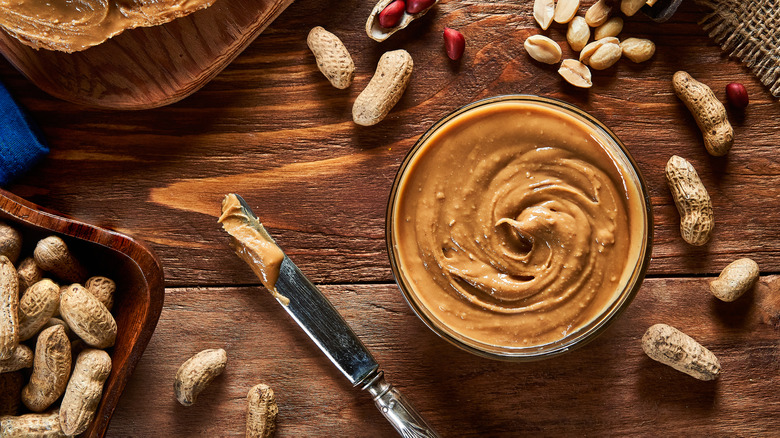Peanut Butter Myths You Can Stop Believing
Peanut butter is so commonplace that we tend to take it for granted. Most of us have a jar of the stuff somewhere in our kitchens, and unless someone in your household has a peanut allergy, it's likely among the first things we reach for when we need a quick but filling breakfast or snack. And for many of us, peanut butter plays a big role in our childhood memories: What school kid didn't open a brown bag lunch and found a peanut butter and jelly sandwich or celery sticks filled with its sticky goodness?
But because peanut butter is so familiar, we think we know everything about it. However, truth can be stranger than fiction. Take, for instance, the urban legend that you can use peanut butter to remove chewing gum from your hair. Well, it turns out it's actually true (although you'll still want a good shampoo after you get the gum out). And the story that you can turn peanut butter into real diamonds? That's true too (though it's neither an efficient nor cost-effective way to procure jewelry). Back in your kitchen, however, you're probably not making the most of your peanut butter because of commonly held, but mistaken, assumptions about it. We're debunking some common myths about peanut butter with a little help from Markita Lewis, a registered dietitian and marketing and communications manager for the National Peanut Board.
Myth: Peanut butter is high in sugar
Because we often associate peanut butter with sweet treats, we tend to assume that it too is sugary and fattening. But peanut butter is not the unhealthy sugar bomb that some may think it is. "People are commonly concerned about the sugar content in peanut butter," Markita Lewis said. "However, the sugar in conventional peanut butter amounts to about ½ teaspoon per serving, which is a very small contribution when you consider the most common sources of added sugar in the diet."
If you'd prefer to avoid even this small amount of added sugar, you can still enjoy natural peanut butter. "Peanut butter is considered 'natural' if it contains just peanuts or peanuts and salt," Lewis explained. "A conventional peanut butter will contain these ingredients, plus the addition of fully hydrogenated oil and possibly added sweeteners." But both types, she added, offer real nutrition and not just empty calories. "No matter which type of peanut butter you choose, you'll still enjoy the nutritional benefits of plant-based protein, fiber, and over 30 essential micronutrients," she said.
Myth: Peanut butter causes acne
Those of us who suffered through acne as adolescents know that the zits are just part of the struggle. Almost as frustrating were the constant lectures that anything and everything that made teenage life more bearable — from staying up late to wearing makeup to enjoying snack foods such as crispy French fries and cream-filled donuts – was making our acne worse. As a result, it became easy to believe that if anything felt or tasted good, it must be bad for our skin — including peanut butter.
But contrary to popular belief, peanut butter will not cause acne nor make it worse. While it's no secret that peanut butter has plenty of oil, dietary fat does not correlate with the oiliness of your skin. Instead, acne has a number of other root causes, including hormonal and genetic factors. And guess what? Eating peanut butter will have no effect on any of these. So you have no need to deny yourself peanut butter if your complexion is acting up. Consider it a harmless and well-deserved pleasure.
Myth: Peanut butter can stop hiccups
Hiccups are mostly harmless, but a long bout can be irksome, not to mention embarrassing in social settings. They're spasms triggered by irritation of the nerves that control the movement of the diaphragm. And while hiccups often occur randomly, they can be associated with actions such as eating or drinking too quickly, smoking, or drinking large quantities of alcohol. Just as random as the causes of hiccups are the many folk remedies to stop them, which include scaring the sufferer and having them swallow a few spoonfuls of peanut butter.
While a good scare can reset your nerves and end a bout of hiccups, doctors recommend simpler remedies, such as sipping on cold water, taking long, slow breaths, and swallowing while you hold your nose. As for the peanut butter trick, there's no evidence it works. Moreover, it can be dangerous: swallowing a large spoonful of peanut butter quickly can lead to choking. Of course, peanut butter is great, but a big gob of it stuck in your throat is not. So the next time you get the hiccups, stick to simpler, proven remedies, and save the peanut butter for when you recover.
Myth: Peanut butter should always be stored in the pantry
A reason peanut butter is such a standby is it's such a low-maintenance food. Most of us just keep a jar in the pantry and pull it out whenever we need some. And many of us go through it so quickly that it never seems to go bad — and this can lead to the mistaken belief that an opened jar of peanut butter can last nearly forever in your pantry. However, this simply isn't true.
"Where you store your peanut butter can have a big impact on how long it stays fresh," Markita Lewis explained. "If stored in the pantry, an open jar of peanut butter can stay fresh for up to three months. After that, it's recommended to store your peanut butter in the fridge where it can maintain its quality for another three to four months. An unopened jar of peanut butter can last between six and nine months when stored in the pantry." Also, note that natural peanut butter should always be refrigerated once opened.
Myth: Peanut butter causes constipation
A whole body of nutritional folklore has evolved around the belief that anything that tastes good must be bad for you. Thankfully for food lovers, much of this has proven untrue. For instance, you need not worry about the old myth that peanut butter causes constipation. (It's unclear how this belief evolved — perhaps the sticky texture of peanut butter led some people to assume it would stick to their bowels, too.)
But unless you have a sensitivity to peanuts, peanut butter won't trigger constipation. If anything, it can have the opposite effect. The oils in peanut butter can facilitate bowel movements, as can the natural fiber in peanuts and other nuts. So if you find yourself with an occasional bout of constipation, try adding a bit of peanut butter to your diet. It'll not only provide a good part of your daily protein needs but, over time, can make you feel a lot better.
Myth: Peanut butter is a no-no if you're trying to lose weight
We're not going to lie: Peanut butter is undeniably rich, which is one of the reasons it tastes so good. And yes, a lot of its rich flavor comes from fat. But as Markita Lewis explains, not all fatty foods are junk food, and not all fat is bad. "There are a lot of misconceptions about dietary fats, but it's crucial to know that fat is important!" she said. "Your body needs fat to function properly, create energy, and absorb essential vitamins. 78% of the fat in peanut butter is good unsaturated fat."
So while you don't want to make peanut butter the cornerstone of your diet if you're trying to lose weight, you don't have to avoid it altogether. Enjoyed in moderation, peanut butter can actually help you stay on track and attain your desired results. And as a bonus, an occasional peanut butter treat can stave off that sense of deprivation that sends so many diets off the rails. "A moderate fat diet that includes peanut butter can actually support weight management and metabolic health," Lewis said.
Myth: Peanut butter is only for children
For many of us, peanut butter is indelibly linked to childhood — our own childhoods in particular. While as small children, we might have grown tired of other everyday foods and stubbornly refused to try new ones, our parents and caregivers knew that we'd always be happy to eat a peanut butter sandwich. So as long as a jar of peanut butter was around, we wouldn't starve.
This would be why a lot of us have a hard time picturing peanut butter as something serious adults with educated palates can enjoy. But if you consider yourself an educated and worldly diner, you owe it to yourself to give peanut butter a second look. "As a familiar ingredient for most, peanuts and peanut butter are the perfect bridge ingredient to try new cuisines and expand your palate," Markita Lewis said. She added that peanut butter is a staple in African and Asian cuisines, so that familiar jar in your pantry can offer a gateway to new-to-you specialties from these cultures. For instance, Lewis recommends trying West African peanut stew featuring sweet potatoes, spinach, roasted peanuts, peanut butter, vegetable broth, and aromatics. Its flavor is both comfortingly familiar and delightfully different.
Myth: Peanut butter is dangerous for dogs
Dog parents know that the relationship between dogs and the human dinner table can be fraught. But whether you find their fondness for begging for table scraps (or stealing them) endearing or exasperating, you need to keep in mind that dogs aren't the best judges of their own nutritional needs. Some foods that are perfectly safe for people, such as chocolate, can be deadly to dogs. Among the human foods that dog lovers often worry about is peanut butter.
Fortunately, they have little reason to fear. Contrary to popular rumors, peanut butter is safe for dogs, with one major exception: If it contains the artificial sweetener xylitol, it is toxic to dogs. So if your dog has developed a fondness for peanut butter and is showing no ill effects, all is well. Just be sure to check the ingredient label of your peanut butter jar before offering any to your dog — many brands do contain xylitol. To be on the safe side, you might want to restrict your dog to natural peanut butter or a brand formulated especially for dogs. And even if your dog loves it, don't overdo it. Even safe varieties of peanut butter offer little nutritional value to dogs except for fat, so it should be enjoyed in moderation.
Myth: Peanut butter is only good in sweet dishes
Quick! Think of your favorite ways to enjoy peanut butter. Chances are, PB&J sandwiches came to mind first, followed by cookies, candy, and maybe apple slices topped with a dab of the sticky stuff. But if these are the only ways you're using peanut butter, you're missing out. "One of the most common misconceptions about cooking with peanut butter is that it's only good for sweet recipes like desserts or breakfast. This isn't true!" Markita Lewis said. "Peanut butter is an incredibly versatile ingredient for cooking and can be wonderful for savory dishes, too. Peanuts and peanut butter are a common savory ingredient across many cultural cuisines."
A main dish application of peanut butter you may already know is the spicy-sweet dipping sauce that accompanies grilled satay skewers in Thai and other Southeast Asian dishes. It's easy to make — just stir together common kitchen staples including soy sauce, garlic, chiles, peanut butter, and a little brown sugar. And if you've ever enjoyed cold sesame noodles from your favorite Chinese takeout, you've had another peanut butter-based sauce. Even peanut butter sandwiches can take a savory turn: If you're feeling adventurous, try a peanut butter and onion sandwich, a favorite of Ernest Hemingway.
Myth: Peanut butter is beloved universally
Many of us grew up with the assumption that peanut butter is an all-American invention, designed by and for us. And being proud Americans, we also tend to assume that anyone who tries this amazing food will instantly fall in love with it. Neither of these popular assumptions, however, are true. While forms of peanut butter exist around the world and it's a popular ingredient in Southeast Asian and West African cuisines, in some parts of the world, people find peanut butter baffling, if not outright disgusting.
For instance, while the populations of Western Europe happily embraced American fast food and popular culture, they took a collective dislike to peanut butter. "I can only speak from my own experience, but it seems to me that peanut butter has been demonized. It is hated. It is considered extremely unhealthy and VERY American," an American expatriate in France shared online. The numbers seem to support this anecdote. When American farmers found themselves with a peanut glut in 2012, they tried desperately to get Europeans to eat (and buy) more peanut butter. But while eaters in the UK, Netherlands, and Germany began to embrace it, no one else did. That year, the average European ate an average of just a tablespoon of peanut butter.
Myth: Crunchy peanut butter is healthier than smooth
Smooth and crunchy peanut butter both have their fans. Lovers of smooth peanut butter appreciate how easily it mixes into smoothies and its clean look on an open-faced sandwich. And lovers of crunchy varieties relish the added texture and flavor that the peanut bits provide. Some crunchy peanut butter fans offer an additional argument in its favor: It's more nutritious because look at all those peanuts!
Unfortunately for crunchy peanut butter fans, this is simply untrue. Crunchy peanut butter is slightly more caloric than smooth, but the difference is minor (190 calories for two tablespoons versus 180 for smooth peanut butter). Apart from that, both have the same nutritional value and offer beneficial nutrients, including B and E vitamins, magnesium, zinc, and protein. So if you enjoy the extra texture and flavor of crunchy peanut butter, go ahead and keep enjoying it. It still offers powerful nutrition — but no more than its smooth counterpart.
Myth: George Washington Carver invented peanut butter
Sometime during your elementary school or middle school years, you probably learned that peanut butter was invented by George Washington Carver, a son of slaves who became a respected agronomist and educator, as well as a prolific inventor. Carver dedicated much of his professional life to promoting the cultivation of peanuts, which provided not only valuable nutrition for people, but also for soil depleted by cotton cultivation. As part of his mission, he devised and promoted dozens of uses for peanuts, ranging from candy and animal feed to household items such as soap and paper.
But while peanut butter was among the products he promoted, Carver was not the first to come up with the idea of a spreadable paste made from peanuts. Ancient Inca and Aztec civilizations had their own versions of ground peanut paste. Today, ground peanuts still appear in Mexican dishes such as mole sauces.
In the U.S., 19th-century inventors, including John Harvey Kellogg (of Kellogg Cereal fame), patented their own processes for making peanut butter. None of this, however, should discount Carver's contributions. Without him, we likely wouldn't have the abundance of peanuts needed for peanut butter to become the staple it is.
Myth: Peanut butter is dangerous for babies and toddlers
Peanut allergies are no joke, and no one can blame new parents for the choice to keep their babies and toddlers as far from peanuts as possible, whether to prevent them from developing an allergy or to prevent a possible allergic reaction. And because of the severity of childhood peanut allergies, some schools have even banned peanut butter, once a regular player in brown-bag lunches. But while all of this is well-intentioned, it may do more harm than good. Research has revealed that the best way to prevent the development of peanut allergies is to introduce peanuts into young children's diets gradually and in small doses.
The American Academy of Allergy, Asthma, and Immunology recommends the following strategy to introduce babies to peanuts, dairy, and other commonly allergenic foods: Wait until your baby has already tried and tolerated other solid foods (between four and six months of age) and offer a first small taste of the new food at home, where you can safely monitor your baby's reaction. If your baby handles it well, you can offer larger servings. However, if your child has had allergic reactions to other foods or has siblings with known food allergies, consult with your pediatrician before you offer your first taste of peanut butter or other potentially allergenic food.
